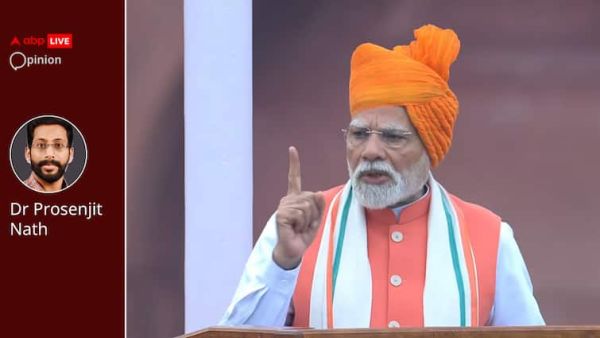
Over the past decade, India's Northeast has undergone a transformation unlike any in its post-independence history. Long seen as a distant outpost connected only through a narrow "chicken's neck" corridor, it was neglected by successive Congress governments and mired in insurgency and underdevelopment. Prime Minister Narendra Modi, through his "Act East" doctrine and focus on connectivity and empowerment, has redrawn this narrative.
The events of September 13-14, 2025, reflect this shift. In two days, Modi inaugurated and laid foundation stones for projects worth over ₹16,000 crore across Mizoram, Manipur, and Assam. These were concrete steps to bind the region with the rest of India physically, economically, and emotionally.
Railways: The Artery Of Integration
The most striking change has been in rail connectivity. Many Northeastern states had no stations, while others relied on colonial-era lines. That changed under Modi. A landmark moment came with the inauguration of the Bairabi–Sairang rail line, finally connecting Mizoram's capital, Aizawl, to the national railway grid.
In Assam, projects like the Kuruwa-Narengi Bridge over the Brahmaputra and the Guwahati Ring Road promise to ease congestion and accelerate trade. Contrast this with Congress's record: the Bogibeel Bridge, Asia's second-longest rail-cum-road bridge, languished for years after 2004 until Modi's government completed it. The Dhola-Sadiya Bridge, the first road link between northern Assam and eastern Arunachal, was also revived only after 2014.
Where Congress saw the Northeast as distant, Modi has treated it as a gateway to prosperity and security.
Empowerment Through Welfare
Infrastructure alone cannot change lives. Modi's welfare schemes have directly impacted millions. In Manipur, 8 lakh farmers benefit from PM-Kisan, 7 lakh families receive rations under PM Garib Kalyan Yojana, and 90,000 houses have been built under PM Awas Yojana.
Under Ayushman Bharat, 5.25 lakh patients have received free medical treatment. The government has also provided 2.5 lakh gas connections, 2.3 lakh electricity connections, and built 40,000 toilets. Oxygen plants were set up in every district during COVID.
This scale of delivery is unprecedented in the region's history and shows Modi's model is about reaching the last mile, something Congress failed to achieve.
Exposing Congress's Neglect
The contrast with Congress could not be sharper. Former Prime Minister Manmohan Singh represented Assam in the Rajya Sabha for 28 years but visited rarely. Rahul Gandhi, an MP since 2004, barely engaged with the region—even during Manipur's 2010–11 unrest, when curfews stretched to 139 days.
Key accords like the Assam Accord (1985), Mizo Accord (1986), and Tripura Accord (1988) were left unfulfilled for decades. Only under Modi were commitments to communities like the Bodos and Karbis implemented, leading to stability.
Electoral results reflect this trust: BJP retained power in Assam in 2021, crushed Congress in Tripura in 2023, and swept polls with allies in Nagaland, leaving Congress with no seats. Its current activism in Manipur smacks of opportunism.
Strategic Importance
Modi's focus is also on security and India's global role. The Sela Tunnel in Arunachal Pradesh, built at 13,000 feet for ₹825 crore, enables rapid troop movement to the Sino-India border. The Pakyong Airport in Sikkim, inaugurated in 2018, boosts civilian and military reach. These projects position the Northeast as India's gateway to Southeast Asia in trade, defence, and diplomacy.
Women-Led Development
Another milestone is women's leadership. In 2023, S Phangnon Konyak became the first Naga woman in the Rajya Sabha and presided over its proceedings—an achievement that took 76 years. Modi's push for women-led development created space for such breakthroughs.
From Margins to Mainstream
The Northeast's story over the past eleven years is one of revival: railways, bridges, AIIMS Guwahati, oxygen plants, peace accords, and welfare schemes. Once trapped in the "tyranny of distance," the region now stands integrated with the national mainstream.
The BJP's victories are not just political but affirmations of trust. At the heart of this transformation is a prime minister who saw potential where others saw only problems.
(The writer is a technocrat, political analyst, and author)
[Disclaimer: The opinions, beliefs, and views expressed by the various authors and forum participants on this website are personal and do not reflect the opinions, beliefs, and views of ABP Network Pvt. Ltd.]
-
10K Drunk Driving Cases In MP's Indore, Yet Road Safety Big Concern

-
Lace Fashion 2025: How Lace Is Reinvented From Romantic Past to Urban Street Style

-
Tragic Accident in Bokaro: Father and Son Killed in Collision
-
Vet urges UK dog owners to feed 1 food to pets - 'packed with nutrients'

-
Indore: 'PM Viksit Bharat Yojna Will Help Realise Dream Of Self-Reliant India' Says Experts In Special Session
